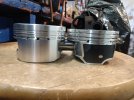Five Reviver
Silver Level Sponsor
I now have the answer from RaceTec: the deck is .210 inches and milling off .114 inches would lead to a deck of .096 inches, and failure.
This doesn't concern me; I bought the pistons with a view to building standard stroke and I'm still happy with that.
Dan, when I said the pistons are the same spec as yours, I guess I was just saying that I gave RaceTec the same dimensions and the part number which they pulled from their records.
This doesn't concern me; I bought the pistons with a view to building standard stroke and I'm still happy with that.
Dan, when I said the pistons are the same spec as yours, I guess I was just saying that I gave RaceTec the same dimensions and the part number which they pulled from their records.



